Use of Parametric Digital Tools in Grasshopper and Python for Optimization of CNC Prefabrication Process in WikiHouse Prototype Construction
Abstract
1. Introduction
2. Materials and Methods
2.1. Methodology
2.2. Population and Sample
2.3. Variables, Dimensions, and Indicators
2.4. Methodological Scheme
3. Results
3.1. Result of Experiment 1: Unloading of Parts
3.1.1. Experimental Group A (Script): Satisfaction Level
3.1.2. Experiment 1: Control Group B (Rhino): Satisfaction Level
3.1.3. Experiment 1: Control Group C (SketchUp): Satisfaction Level
3.1.4. General Survey Results
3.2. Result of Experiment 2: Classification and Quantification of Parts for Manufacturing
3.2.1. Experiment 2: Experimental Group A (Script): Satisfaction Level
3.2.2. Experiment 2: Control Group B (Rhino): Satisfaction Level
3.2.3. Experiment 2: Control Group C (SketchUp): Satisfaction Level
3.2.4. General Survey Results
3.3. Láser Result of Experiment 3: Transformation of CNC Router Data to Laser
3.3.1. Experiment 3: Experimental Group A (Script): Satisfaction Level
3.3.2. Experiment 3: Control Group B (Rhino): Satisfaction Level
3.3.3. Experiment 3: Control Group C (SketchUp): Satisfaction Level
3.3.4. General Survey Results
3.4. Result of Experiment 4: Nesting the CNC Laser Data (Material Optimization)
3.4.1. Experiment 4: Experimental Group A (Script): Satisfaction Level
3.4.2. Experiment 4: Control Group B (Rhino): Satisfaction Level
3.4.3. Experiment 4: Control Group C (SketchUp): Satisfaction Level
3.4.4. General Survey Results
3.5. General Results of the 4 Experiments
3.5.1. Experiment 1: Unloading Parts
- Group A used a parametric algorithm developed in Grasshopper, composed of native components and custom Python scripts, aimed at automating the download of the 2D files corresponding to the WikiHouse parts. The system established a direct link between the nomenclature of each component and its respective address in the GitHub repository, simultaneously generating a default destination path on the desktop of each test subject. This configuration reduced manual intervention and minimized errors due to omission, while maintaining traceability between the digital model and the manufacturing files.
- Group B executed the download process manually from WikiHouse’s GitHub repository, selecting and storing each file individually. This approach required more execution time and visual control, as it lacked validation mechanisms or automatic detection of missing files.
- Group C downloaded the file through the official WikiHouse website, also using a manual and sequential process. The lack of automation led to greater exposure to human error, as well as delays resulting from the individual search and management of files.
3.5.2. Experiment 2: Classification and Quantification of Parts for Manufacturing
- Group A used a parametric algorithm developed in Grasshopper, programmed to automatically detect, classify, and count each element present in the 3D model within the Rhinoceros 3D environment. The system displayed real-time reading panels with the nomenclature and exact number of units per part type, eliminating the need for manual intervention and ensuring data accuracy and traceability.
- Group B worked directly in Rhinoceros, using native tools to visually isolate the components, proceed with their manual identification, and record the count individually. This procedure required more execution time and presented risks of inconsistencies in data transcription.
- Group C performed the task in SketchUp, following a completely manual process of visualization, counting, and identification, without the support of automated routines. This involved considerable operational effort and a higher probability of classification errors.
3.5.3. Experiment 3: Transforming CNC Router Data to Laser
- Group A used the information derived from experiments 1 and 2, utilizing the exact parts list and their 2D geometries. These were imported into the three-dimensional environment of Rhino 8, where an algorithm with integrated scripts designed to automate geometric debugging and optimize cutting paths was applied. The procedure concluded with the generation of 2D files ready for manufacturing, with a clean format compatible with laser cutting systems.
- Group B manually modified the parts within Rhino 8, using only the software’s native tools. This method required more operating time and manual precision, increasing the likelihood of geometric inconsistencies.
- Group C replicated the procedure manually in AutoCAD, using the program’s native tools to edit, simplify, and debug the 2D geometries. Like Group B, the process was longer and depended on human intervention.
3.5.4. Experiment 4: Nesting the CNC Laser Data (Material Optimization)
- Group A used the automated algorithm, which performed the nesting process comprehensively, considering both the number of parts and the spatial efficiency of the layout. The system rearranged, coded, and arranged the parts in Rhino, generating a file ready for the laser cutting process.
- Group B performed the nesting manually in Rhino 8, duplicating the parts according to the required quantity and arranging them on the sheets without automated assistance, relying solely on the operator’s experience to optimize space.
- Group C replicated the procedure in AutoCAD, using the program’s native tools to duplicate, rotate, and distribute the parts manually. Like Group B, the process relied entirely on human manipulation and visual estimation to achieve optimization.
3.6. Hypothesis Testing Results of the Experiments
3.6.1. Hypothesis Testing for Experiment 1
- Hypothesis for Experiment 1: The use of parametric digital tools reduces the download times of 3D components required for the production of Wikihouse prototypes.
- H1: Null Hypothesis: The use of parametric digital tools reduces the download times of 3D components required for the production of Wikihouse prototypes.
- H0: Alternative Hypothesis: The use of parametric digital tools does not reduce the download times of 3D components required for the production of Wikihouse prototypes.
3.6.2. Hypothesis Testing of Experiment 2
- Hypothesis of Experiment 2: The use of digital tools verifies and reduces errors in the components necessary for the manufacture of Wikihouse prototypes.
- H1: Null Hypothesis: The use of digital tools verifies and reduces errors in the components required for the manufacture of Wikihouse prototypes.
- H0: Alternative Hypothesis: The use of digital tools does not verify and reduce errors in the components required for Wikihouse prototype manufacturing.
3.6.3. Hypothesis Testing of Experiment 3
- Hypothesis of Experiment 3: The use of digital tools reduces the classification execution time, minimizes the percentage of errors in the quantification and classification of components and reduces the download times of 2D components necessary for the manufacture of Wikihouse prototypes.
- H1: Null Hypothesis: The use of digital tools reduces the execution time of the classification, minimizes the percentage of errors in the quantification and classification of the components and reduces the download times of 2D components necessary for the manufacture of Wikihouse prototypes.
- H0: Alternative Hypothesis: The use of digital tools does not reduce the execution time of the classification, minimize the percentage of errors in the quantification and classification of the components and reduce the download times of 2D components necessary for the manufacture of Wikihouse prototypes.
3.6.4. Hypothesis Testing of Experiment 4
- Hypothesis of Experiment 4: The use of digital tools reduces the execution time of the transformation and minimizes the percentage of errors in the transformation of data from CNC Laser to CNC Router for the manufacture of prototypes Wikihouse.
- H1: Null Hypothesis: The use of digital tools reduces the execution time of the transformation and minimizes the percentage of errors in the transformation of data from CNC Laser to CNC Router for the manufacture of Wikihouse prototypes.
- H0: Alternative Hypothesis: The use of digital tools does not reduce the execution time of the transformation and minimizes the percentage of errors in the transformation of data from CNC Laser to CNC Router for the manufacture of prototypes Wikihouse.
4. Discussion
4.1. Transfer Models: Open–Granular vs. Robotic–Compact
4.2. Operational and Material Efficiencies
4.3. Contextual Validation and Pragmatic Transfer
4.4. Limitations
4.5. Implications for Adoption (Micro-Factories, Fab Labs, Open Housing)
The Role of Academia as a Transfer Vector
4.6. Next Steps
- Open parametric constructions with seismic variables. Families/templates (Grasshopper/Revit/BlenderBIM) of panels, diaphragms, and joints with parameters for target drift, ductility, resistance hierarchy, and detailing; cyclic test protocols (load history, failure mechanisms, anchors) and performance models by typology.
- BIM/IFC interoperability for manufacturing and disassembly. Mapping to IFC 4.x with properties for kerf, offsets, cutting order, part codes, reuse, and DFMA/DfD; validation through Model View Definitions (MVD) and round-trip tests (design→IFC→fabrication) without semantic loss.
- Automated verification (rule-checking). Parametric rules for compliance (drift ≤ limit, connector spacing, clearances, cutting sequences) and non-conformity metrics detected prior to fabrication.
- Tolerances and environment in the solver. Incorporate real kerf, tool wear, humidity, and expansion/contraction in nesting and assembly; measure design-to-piece deviation (mm), reworks, and on-site adjustments.
- LCA + cost coupling to the design-fabrication flow. A1–A4 inventories, machine energy/time, cost per m2 of cutting and per joint; report Pareto curves (cost–carbon–time) for public-policy decisions.
- Adoptability with non-expert crews. Measure onboarding time, cognitive load (e.g., NASA-TLX), errors and rework per joint with and without parametric guides.
- Reproducible repository (when applicable). Datasets of hysteretic responses, times per joint, and typical errors with metadata and DOI; 15–30 min reproducible examples for initial training.
4.7. Synthesis
5. Conclusions
Author Contributions
Funding
Data Availability Statement
Acknowledgments
Conflicts of Interest
References
- Yudhistira, A.T.; Satyarno, I.; Nugroho, A.S.B.; Handayani, T.N. Effect of Construction Delays and the Preventive Role of Concrete Works Optimization: Systematic Literature Review. TEM J. 2024, 13, 1203–1217. [Google Scholar] [CrossRef]
- Sambasivan, M.; Soon, Y.W. Causes and Effects of Delays in Malaysian Construction Industry. Int. J. Proj. Manag. 2007, 25, 517–526. [Google Scholar] [CrossRef]
- Shufrin, I.; Pasternak, E.; Dyskin, A. Environmentally Friendly Smart Construction—Review of Recent Developments and Opportunities. Appl. Sci. 2023, 13, 12891. [Google Scholar] [CrossRef]
- Abanda, F.H.; Byers, L. An Investigation of the Impact of Building Orientation on Energy Consumption in a Domestic Building Using Emerging BIM (Building Information Modelling). Energy 2016, 97, 517–527. [Google Scholar] [CrossRef]
- Karimi, H.; Timothy, R.; Dadi, G.; Goodrum, P.; Srinivasan, C. Impact of Skilled Labor Availability on Construction Project Cost Performance. J. Constr. Eng. Manag. 2018, 144. [Google Scholar] [CrossRef]
- Tey, J.S.; Goh, K.C.; Seow, T.W.; Goh, H.H. Challenges in Adopting Sustainable Materials in Malaysian Construction Industry. 2013. Available online: https://www.irbnet.de/daten/iconda/CIB_DC26777.pdf (accessed on 20 October 2025).
- Formoso, C.T.; Soibelman, L.; De Cesare, C.; Isatto, E.L. Material Waste in Building Industry: Main Causes and Prevention. J. Constr. Eng. Manag. 2002, 128, 316–325. [Google Scholar] [CrossRef]
- Osmani, M.; Glass, J.; Price, A.D.F. Architects’ Perspectives on Construction Waste Reduction by Design. Waste Manag. 2008, 28, 1147–1158. [Google Scholar] [CrossRef] [PubMed]
- United Nations Environment Programme. Building Materials and the Climate: Constructing a New Future; UNEP: Nairobi, Kenya, 2023; Available online: https://www.unep.org/resources/report/building-materials-and-climate-constructing-new-future (accessed on 20 June 2025).
- De Brabandere, L.; Grigorjev, V.; Van den Heede, P.; Nachtergaele, H.; Degezelle, K.; De Belie, N. Using Fines from Recycled High-Quality Concrete as a Substitute for Cement. Sustainability 2025, 17, 1506. [Google Scholar] [CrossRef]
- World Steel Association. Climate Change and the Production of Iron and Steel; World Steel Association: Brussels, Belgium, 2021; Available online: https://worldsteel.org/climate-action/climate-change-and-the-production-of-iron-and-steel/worldsteel.org (accessed on 15 May 2025).
- Peteck, J.; Glavic, P.; Kostevsek, A. Comprehensive approach to increase energy efficiency based on versatile industrial practices. J. Clean. Prod. 2016, 112, 2813–2821. [Google Scholar] [CrossRef]
- Le Quéré, C.; Andrew, R.M.; Friedlingstein, P.; Sitch, S.; Pongratz, J.; Manning, A.C.; Korsbakken, J.I.; Peters, G.P.; Canadell, J.G.; Jackson, R.B.; et al. Global Carbon Budget 2016. Earth Syst. Sci. Data 2016, 8, 605–649. [Google Scholar] [CrossRef]
- Pintos, P. DFAB House/NCCR Digital Fabrication. ArchDaily 2020. Available online: https://www.archdaily.com/942221/dfab-house-eth-zurich-plus-nccr-digital-fabrication (accessed on 10 July 2025).
- Graser, K.; Kahlert, A.; Hall, D.M. DFAB HOUSE: Implications of a building-scale demonstrator for adoption of digital fabrication in AEC. Constr. Manag. Econ. 2021, 39, 853–873. [Google Scholar] [CrossRef]
- ArchDaily. Pabellón Paramétrico DIGFABMTY: Proyecto Experimental de Estudiantes Mexicanos. ArchDaily Perú, 2015. Available online: https://www.archdaily.pe/pe/773482/pabellon-parametrico-digfabmty-proyecto-experimental-de-estudiantes-mexicanos (accessed on 19 May 2025).
- Esenarro, D.; Porras, E.; Ventura, H.; Figueroa, J.; Raymundo, V.; Castañeda, L. Use of Digital Tools (Wikihouse System) in Multi-Local Social Housing. Sustainability 2024, 16, 3231. [Google Scholar] [CrossRef]
- Taherdoost, H. What are Different Research Approaches? Comprehensive Review of Qualitative, Quantitative, and Mixed Method Research, Their Applications, Types, and Limitations. J. Manag. Sci. Eng. Res. 2022, 5, 53–63. [Google Scholar] [CrossRef]
- Mulisa, F. When Does a Researcher Choose a Quantitative, Qualitative, or Mixed Research Approach? Interchange 2021, 53, 113–131. [Google Scholar] [CrossRef]
- Ramos-Galarza, C. Los Alcances de una investigación. CienciAmérica 2020, 9, 1–6. [Google Scholar] [CrossRef]
- Castro Maldonado, J.J.; Gómez Macho, L.K.; Camargo Casallas, E. La investigación aplicada y el desarrollo experimental en el fortalecimiento de las competencias de la sociedad del siglo XXI. Tecnura 2023, 27, 140–174. [Google Scholar] [CrossRef]
- Shi, Y.; Wang, D.; Zhang, Z. Categorical Evaluation of Scientific Research Efficiency in Chinese Universities: Basic and Applied Research. Sustainability 2022, 14, 4402. [Google Scholar] [CrossRef]
- Agudelo Viana, L.; Aigneren Aburto, J. Diseños de Investigación Experimental y No-Experimental; Universidad de Antioquia, Facultad de Ciencias Sociales y Humanas: Medellín, Colombia, 2008; Available online: http://hdl.handle.net/10495/2622 (accessed on 18 June 2025).
- Miller, C.J.; Smith, S.N.; Pugatch, M. Experimental and quasi-experimental designs in implementation research. Psychiatry Res. 2020, 283, 112452. [Google Scholar] [CrossRef] [PubMed]
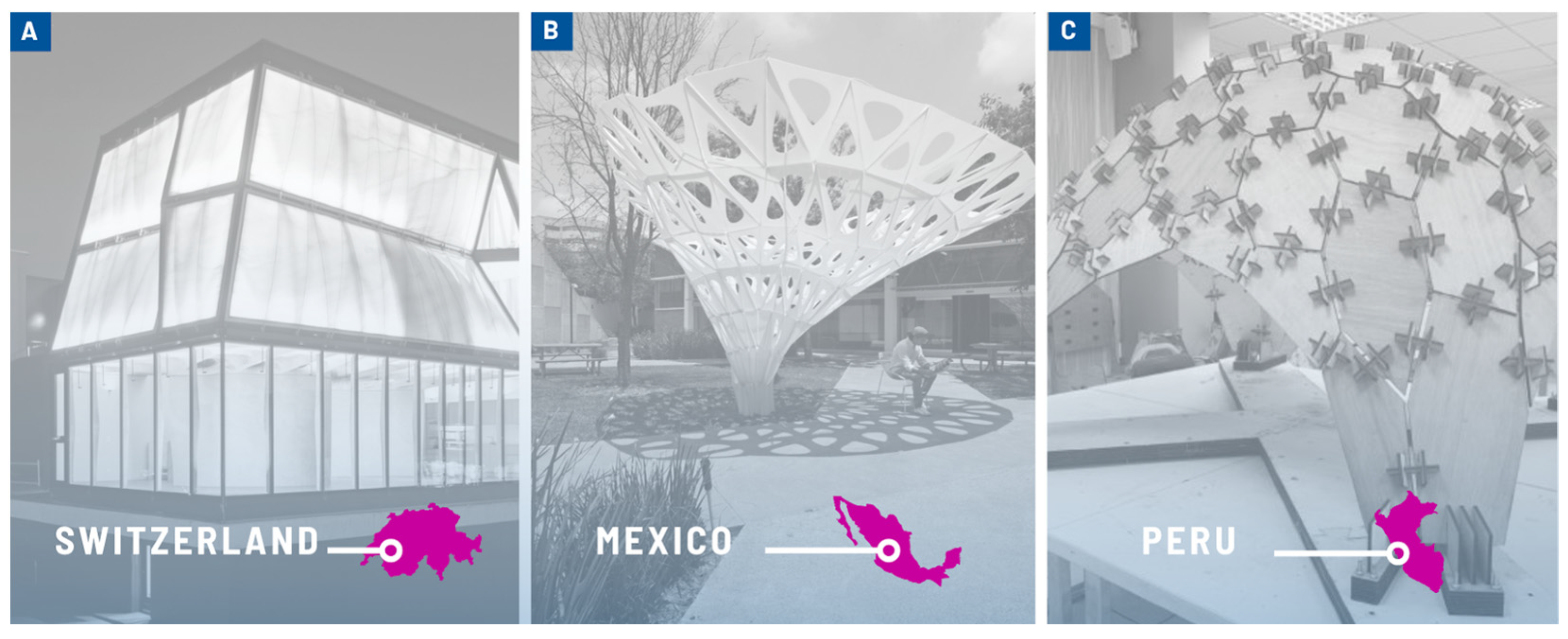
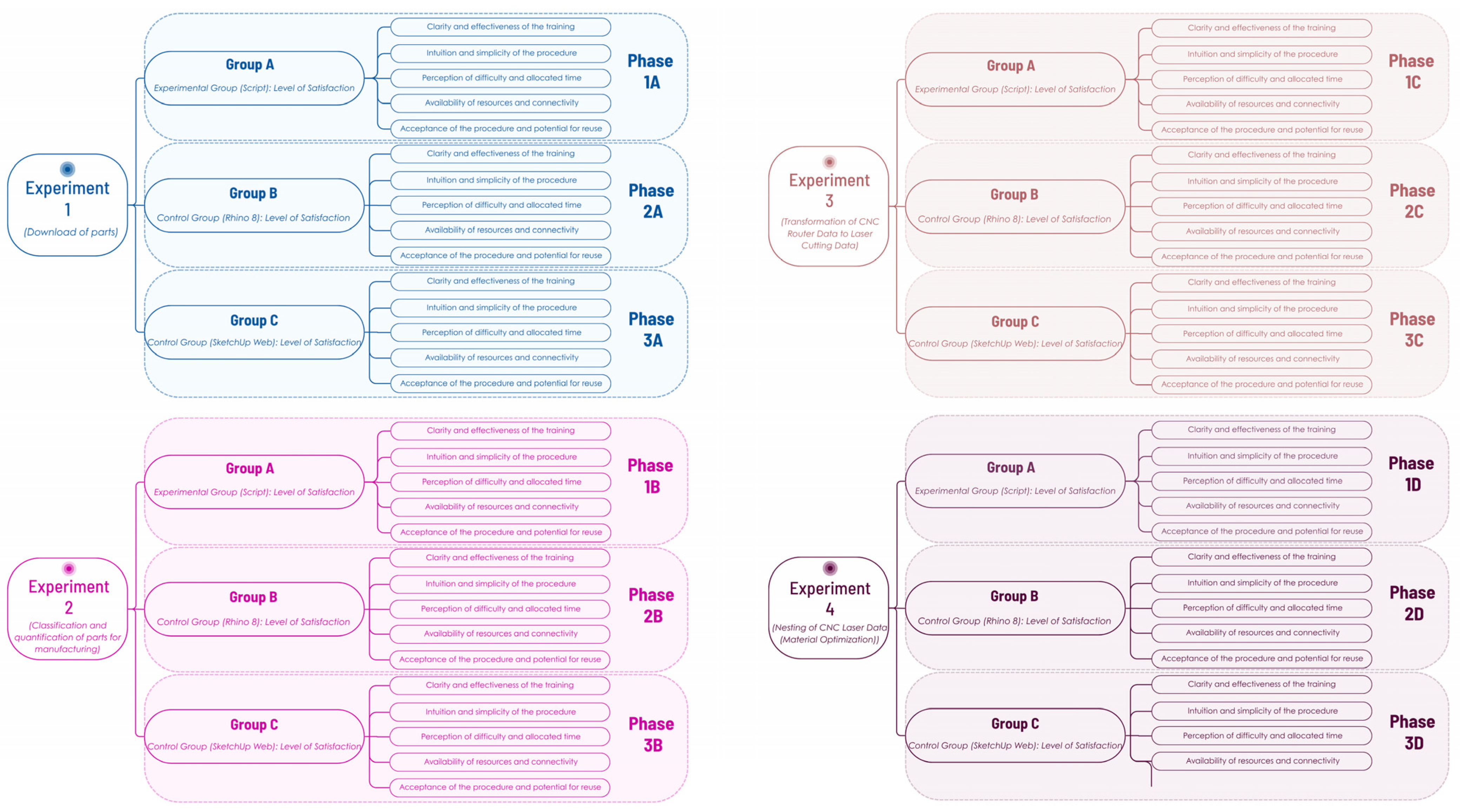
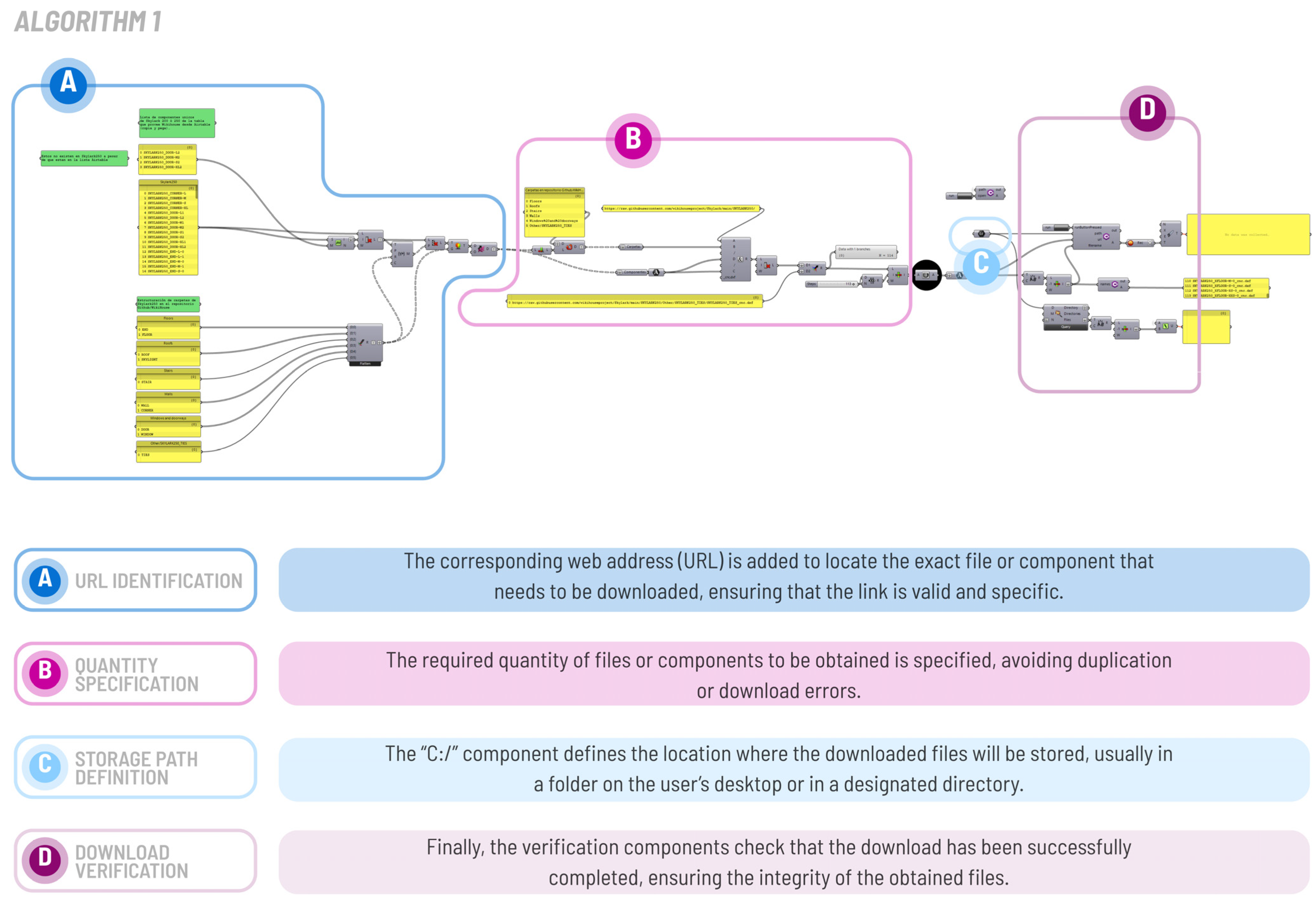
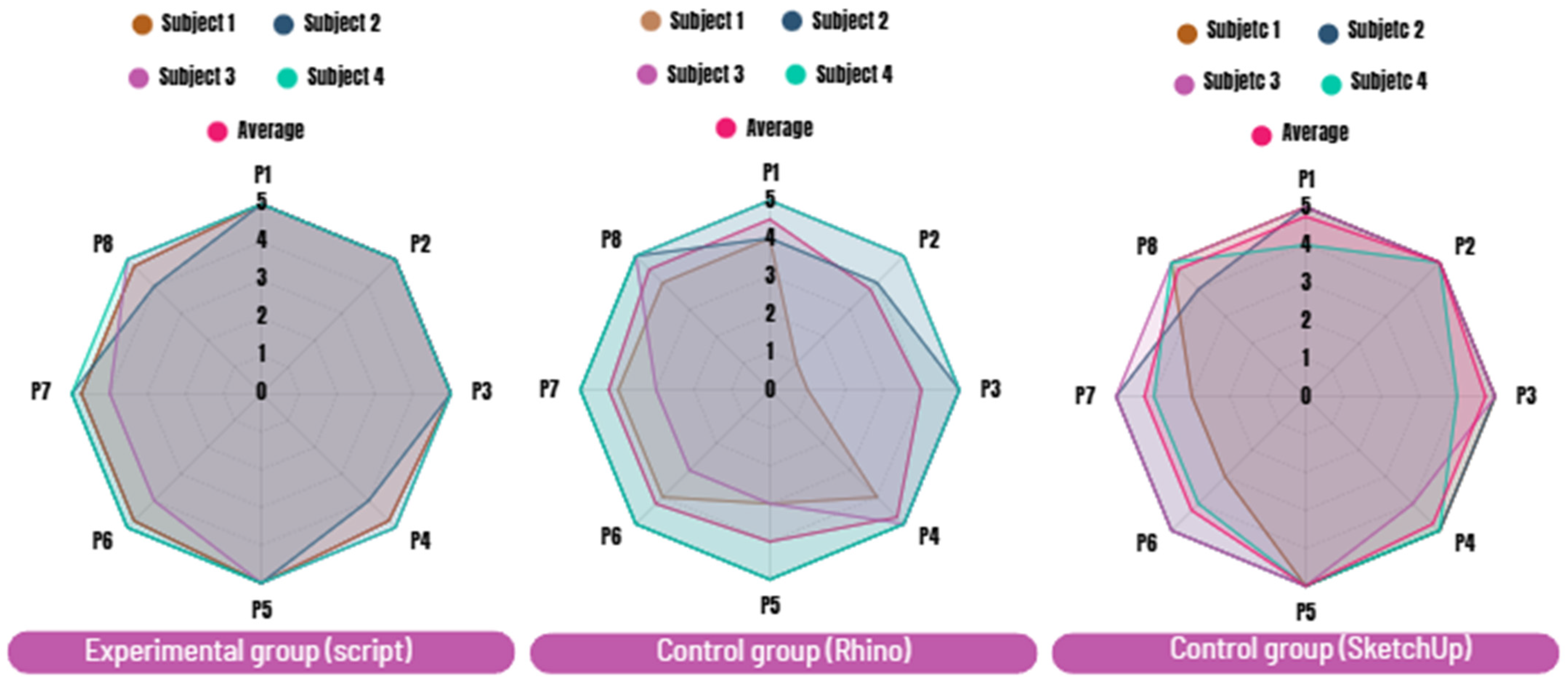


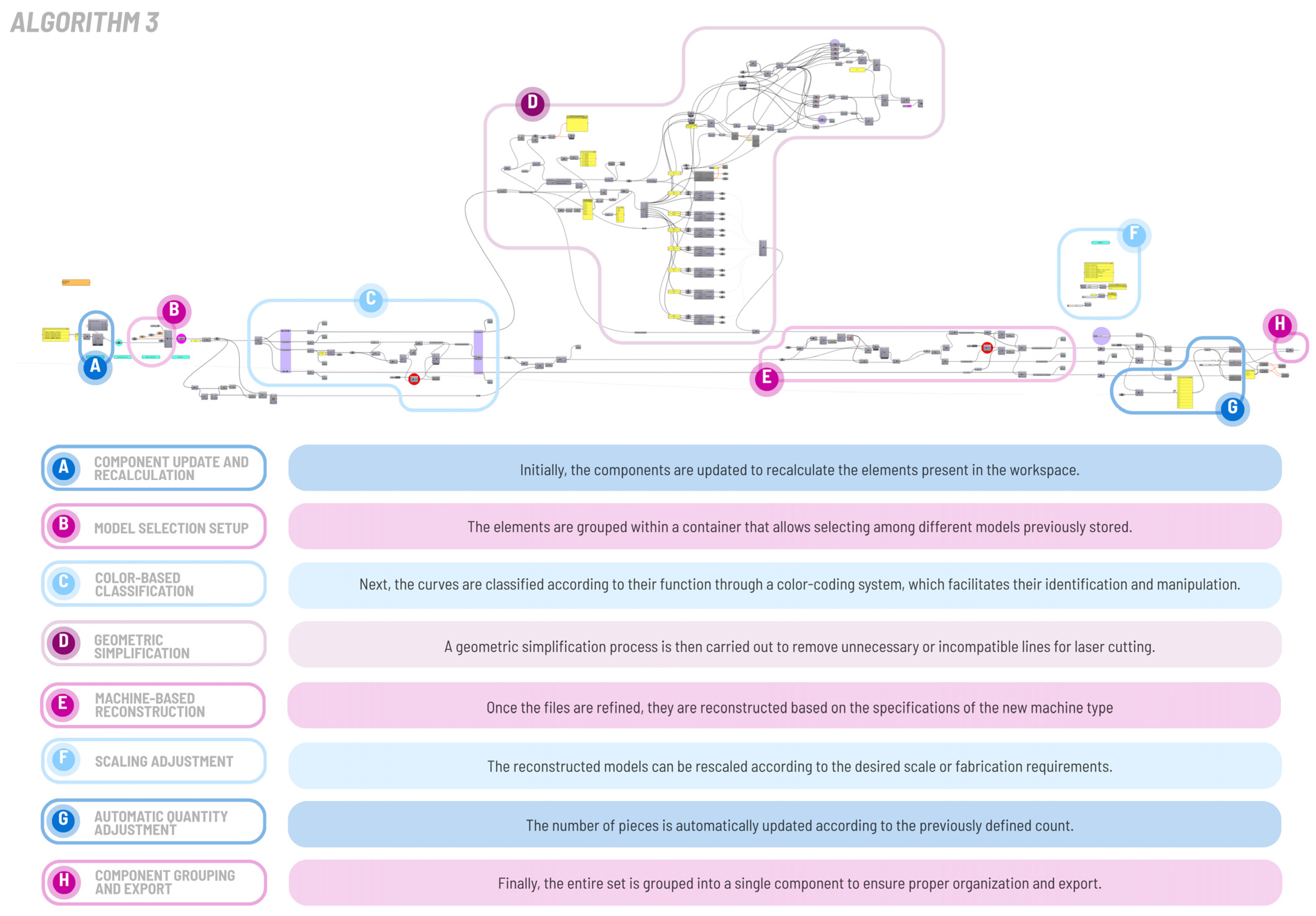

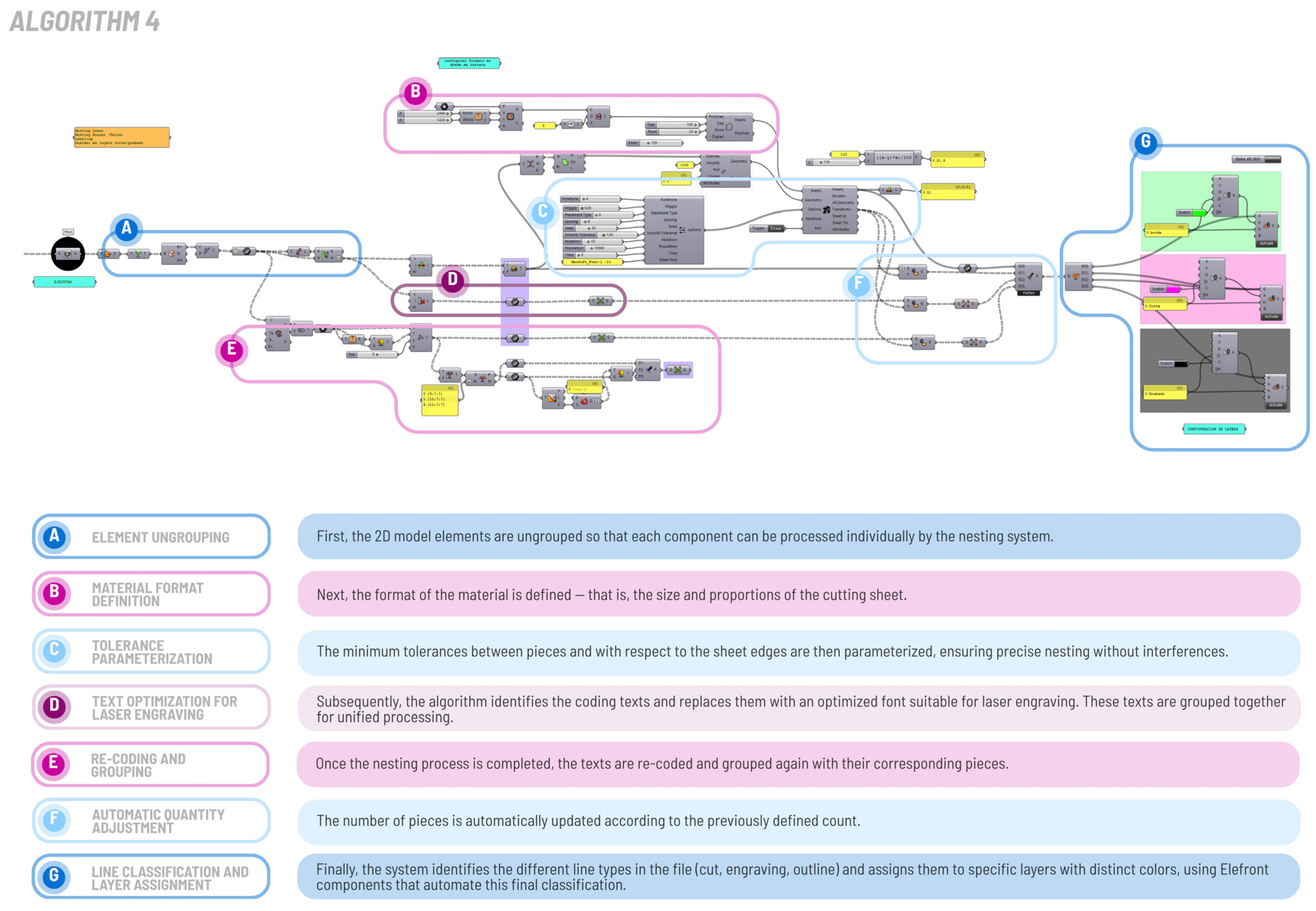

| Variables | Dimensions | Indicators | Techniques and Instruments |
|---|---|---|---|
| Use of parametric digital tools in Grasshopper and Python (X) | Ease of use (X1) | Level of understanding of the procedure Ease in executing commands and scripts | – Likert-type survey – Direct observation |
| Accessibility (X2) | Availability of software and digital resources Compatibility with devices or systems | ||
| Training (X3) | Clarity of the instruction received Autonomy achieved after training | ||
| Perceived difficulty (X4) | Degree of complexity perceived in the use of the software Estimated adaptation time | ||
| Optimization of the pre-fabrication process (Y) | Execution time (Y1) | Total time spent completing each task or experiment | Stopwatch Control sheet |
| Precision (Y2) | Degree of accuracy of the generated pieces in relation to the digital model | Direct observation Control sheet | |
| Margin of error (Y3) | Difference between theoretical dimensions and those obtained in the final piece | ||
| Material waste (Y4) | Percentage of material not utilized during the cutting or assembly process |
| Questionnaire for Control and Experimental Groups | ||||||||
|---|---|---|---|---|---|---|---|---|
| Indicators | Questions | Control | Experimental | Likert Scale | ||||
| 1 | 2 | 3 | 4 | 5 | ||||
| Training | 1 | The instructions provided for conducting the experiment were clear and easy to understand. | The instructions provided for conducting the experiment were clear and easy to understand. | Strongly disagree | Disagree | Neither agree nor disagree | Agree | Strongly agree |
| Simplicity | 2 | The interface I used (software/web) was intuitive, visually clear, and easy to follow. | The interface I used (software/web) was intuitive, visually clear, and easy to follow. | |||||
| Perceived Difficulty | 3 | The time assigned to complete the experiments was sufficient to finish them. | The time assigned to complete the experiments was sufficient to finish them. | |||||
| Training | 4 | I received adequate support from the staff in charge to resolve technical questions or difficulties. | I received adequate support from the staff in charge to resolve technical questions or difficulties. | |||||
| Simplicity | 5 | The technical procedures and instructions were easy to follow. | The technical procedures and instructions were easy to follow. | |||||
| Access | 6 | The facilities and equipment were available without delays. | The facilities and equipment were available without delays. | |||||
| Access | 7 | The internet connection on the available equipment was sufficient to perform the experiment. | The internet connection on the available equipment was sufficient to perform the experiment. | |||||
| Perceived Difficulty | 8 | I believe there were no significant barriers that affected my performance during the experiments. | I believe there were no significant barriers that affected my performance during the experiments. | |||||
| Group | Participant | Execution Time (min) | Average (min) |
|---|---|---|---|
| Experimental Group (Script) | Subject 1 | 1.07 | 1 m 15 s |
| Subject 2 | 1.38 | ||
| Subject 3 | 1.12 | ||
| Subject 4 | 1.18 | ||
| Control Group (Rhino) | Subject 5 | 76.3 | 90 m |
| Subject 6 | 103.7 | ||
| Subject 7 | 94.5 | ||
| Subject 8 | 85.5 | ||
| Control Group (SKP) | Subject 9 | 21.8 | 25 m |
| Subject 10 | 28.4 | ||
| Subject 11 | 26.7 | ||
| Subject 12 | 23.1 |
| Experimental Group (Script) | Control Group (Rhino) | Control Group (SketchUp) | ||||||||||||||
|---|---|---|---|---|---|---|---|---|---|---|---|---|---|---|---|---|
| Indicator | Questions | Subjects | Average | Subjects | Average | Subjects | Average | |||||||||
| S1 | S2 | S3 | S4 | S5 | S6 | S7 | S8 | S9 | S10 | S11 | S12 | |||||
| Capacitation | 1 | 5 | 5 | 5 | 5 | 5 | 4 | 4 | 5 | 5 | 4.5 | 5 | 5 | 5 | 4 | 4.75 |
| Simplicity | 2 | 5 | 5 | 5 | 5 | 5 | 1 | 4 | 5 | 5 | 3.75 | 5 | 5 | 5 | 5 | 5 |
| Perceived difficulty | 3 | 5 | 5 | 5 | 5 | 5 | 1 | 5 | 5 | 5 | 4 | 5 | 5 | 5 | 4 | 4.75 |
| Capacitation | 4 | 5 | 4 | 5 | 5 | 4.75 | 4 | 5 | 5 | 5 | 4.75 | 5 | 5 | 4 | 5 | 4.75 |
| Simplicity | 5 | 5 | 5 | 5 | 5 | 5 | 3 | 5 | 3 | 5 | 4 | 5 | 5 | 5 | 5 | 5 |
| Access | 6 | 5 | 5 | 4 | 5 | 4.75 | 4 | 5 | 3 | 5 | 4.25 | 3 | 5 | 5 | 4 | 4.25 |
| Access | 7 | 5 | 5 | 4 | 5 | 4.75 | 4 | 5 | 3 | 5 | 4.25 | 3 | 5 | 5 | 4 | 4.25 |
| Perceived difficulty | 8 | 5 | 4 | 5 | 5 | 4.75 | 4 | 5 | 5 | 5 | 4.5 | 5 | 4 | 5 | 5 | 4.75 |
| Group | Participant | Execution Time (min) | Average Time (min) | % Correct Classification | % Correct Accounting | % Margin of Error |
|---|---|---|---|---|---|---|
| Experimental Group (Script) | Subject 1 | 2:15 | 1:51 | 100 | 100 | 0 |
| Subject 2 | 1:28 | 100 | 100 | 0 | ||
| Subject 3 | 1:40 | 100 | 100 | 0 | ||
| Subject 4 | 2:00 | 100 | 100 | 0 | ||
| Control Group (Rhino) | Subject 5 | 38:2 | 34:20 | 84.21 | 85.1 | 15.30 |
| Subject 6 | 32:45 | 89.5 | 88.9 | 10.8 | ||
| Subject 7 | 29:32 | 89.5 | 92.6 | 8.95 | ||
| Subject 8 | 37:1 | 94.7 | 96.3 | 4.5 | ||
| Control Group (SKP) | Subject 9 | 36:3 | 32:29 | 95.00 | 90.00 | 7.5 |
| Subject 10 | 32:2 | 84.2 | 85.2 | 15.3 | ||
| Subject 11 | 26:47 | 73.7 | 77.8 | 24.25 | ||
| Subject 12 | 35:4 | 84.2 | 88.9 | 13.45 |
| Experimental Group (Script) | Control Group (Rhino) | Control Group (SketchUp) | ||||||||||||||
|---|---|---|---|---|---|---|---|---|---|---|---|---|---|---|---|---|
| Indicator | Questions | Subjects | Average | Subjects | Average | Subjects | Average | |||||||||
| S1 | S2 | S3 | S4 | S5 | S6 | S7 | S8 | S9 | S10 | S11 | S12 | |||||
| Capacitation | 1 | 5 | 5 | 5 | 5 | 5 | 5 | 5 | 5 | 4 | 4.75 | 5 | 5 | 4 | 5 | 4.75 |
| Simplicity | 2 | 5 | 5 | 5 | 5 | 5 | 4 | 5 | 5 | 5 | 4.75 | 5 | 5 | 4 | 5 | 4.75 |
| Perceived difficulty | 3 | 5 | 5 | 5 | 5 | 5 | 4 | 5 | 5 | 5 | 4.75 | 5 | 5 | 3 | 5 | 4.75 |
| Capacitation | 4 | 5 | 4 | 5 | 5 | 4.75 | 5 | 5 | 5 | 5 | 5 | 5 | 5 | 5 | 5 | 5 |
| Simplicity | 5 | 5 | 5 | 5 | 5 | 5 | 5 | 5 | 5 | 5 | 5 | 5 | 5 | 4 | 5 | 4.75 |
| Access | 6 | 5 | 5 | 5 | 5 | 5 | 5 | 5 | 5 | 5 | 5 | 5 | 4 | 5 | 4 | 4.5 |
| Access | 7 | 5 | 5 | 5 | 5 | 5 | 5 | 5 | 5 | 4 | 4.75 | 4 | 4 | 5 | 5 | 4.5 |
| Perceived difficulty | 8 | 5 | 4 | 5 | 5 | 5 | 5 | 5 | 5 | 5 | 5 | 5 | 5 | 5 | 4 | 4.5 |
| Group | Participant | Execution Time (min) | Average Time (min) | % Correct Transformation |
|---|---|---|---|---|
| Experimental Group (Script) | Subject 1 | 2:05 | 3:54 | 100 |
| Subject 2 | 3:16 | 100 | ||
| Subject 3 | 7:40 | 100 | ||
| Subject 4 | 2:36 | 100 | ||
| Control Group (Rhino) | Subject 5 | 33:01 | 29:43 | 89.4 |
| Subject 6 | 42:20 | 94.7 | ||
| Subject 7 | 27:11 | 100 | ||
| Subject 8 | 16:21 | 84.2 | ||
| Control Group (SKP) | Subject 9 | 33:26 | 41:34 | 94.7 |
| Subject 10 | 42:41 | 78.94 | ||
| Subject 11 | 50:15 | 100 | ||
| Subject 12 | 39:52 | 94.7 |
| Experimental Group (Script) | Control Group (Rhino) | Control Group (SketchUp) | ||||||||||||||
|---|---|---|---|---|---|---|---|---|---|---|---|---|---|---|---|---|
| Indicator | Questions | Subjects | Average | Subjects | Average | Subjects | Average | |||||||||
| S1 | S2 | S3 | S4 | S5 | S6 | S7 | S8 | S9 | S10 | S11 | S12 | |||||
| Capacitation | 1 | 5 | 5 | 5 | 5 | 5 | 5 | 5 | 5 | 4 | 4.75 | 5 | 4 | 5 | 4 | 4.25 |
| Simplicity | 2 | 5 | 5 | 5 | 5 | 5 | 5 | 4 | 5 | 5 | 4.75 | 5 | 4 | 5 | 5 | 4.75 |
| Perceived difficulty | 3 | 5 | 5 | 5 | 5 | 5 | 4 | 5 | 5 | 5 | 4.75 | 5 | 5 | 5 | 4 | 4.75 |
| Capacitation | 4 | 5 | 4 | 5 | 5 | 5 | 4 | 5 | 5 | 5 | 4.75 | 5 | 5 | 4 | 5 | 5 |
| Simplicity | 5 | 5 | 5 | 5 | 5 | 5 | 4 | 5 | 5 | 4 | 4.5 | 4 | 4 | 5 | 4 | 5.25 |
| Access | 6 | 5 | 4 | 5 | 5 | 4.75 | 4 | 5 | 5 | 5 | 4.75 | 5 | 3 | 5 | 5 | 4.5 |
| Access | 7 | 5 | 4 | 3 | 5 | 4.25 | 4 | 5 | 5 | 5 | 4.75 | 5 | 4 | 5 | 5 | 4.75 |
| Perceived difficulty | 8 | 5 | 5 | 5 | 5 | 5 | 3 | 3 | 5 | 4 | 4.25 | 5 | 4 | 5 | 3 | 4.75 |
| Group | Participant | Execution Time (min) | Average Time (min) | Number of Plates | Average Quantity |
|---|---|---|---|---|---|
| Experimental Group (Script) | Subject 1 | 0:32 | 0:52 | 52 | 52 |
| Subject 2 | 0:56 | 52 | |||
| Subject 3 | 0:42 | 52 | |||
| Subject 4 | 1:16 | 52 | |||
| Control Group (Rhino) | Subject 5 | 69:48 | 78:44 | 54 | 54.5 |
| Subject 6 | 56:48 | 55 | |||
| Subject 7 | 79:16 | 55 | |||
| Subject 8 | 109:05 | 54 | |||
| Control Group (SKP) | Subject 9 | 60:47 | 63:32 | 55 | 56.5 |
| Subject 10 | 69:27 | 56 | |||
| Subject 11 | 31:06 | 57 | |||
| Subject 12 | 92:48 | 58 |
| Group | Participant | Total Material (m2) | Average Total Material (m2) | Total Material Wasted (m2) | Waste (%) | Average Waste (%) |
|---|---|---|---|---|---|---|
| Experimental Group (Script) | Subject 1 | 154.79 | 154.79 | 32.6 | 21.06 | 21.06 |
| Subject 2 | 154.79 | 32.6 | 21.06 | |||
| Subject 3 | 154.79 | 32.6 | 21.06 | |||
| Subject 4 | 154.79 | 32.6 | 21.06 | |||
| Control Group (Rhino) | Subject 5 | 160.74 | 162.23 | 42.29 | 26.31 | 24.1 |
| Subject 6 | 163.72 | 35.84 | 21.89 | |||
| Subject 7 | 163.72 | 35.84 | 21.89 | |||
| Subject 8 | 160.74 | 42.29 | 26.31 | |||
| Control Group (SKP) | Subject 9 | 163.72 | 168.19 | 35.84 | 21.89 | 25.2 |
| Subject 10 | 166.70 | 42.29 | 25.37 | |||
| Subject 11 | 169.67 | 45.33 | 26.72 | |||
| Subject 12 | 172.65 | 46.31 | 26.82 |
| Experimental Group (Script) | Control Group (Rhino) | Control Group (SketchUp) | ||||||||||||||
|---|---|---|---|---|---|---|---|---|---|---|---|---|---|---|---|---|
| Indicator | Questions | Subjects | Average | Subjects | Average | Subjects | Average | |||||||||
| S1 | S2 | S3 | S4 | S5 | S6 | S7 | S8 | S9 | S10 | S11 | S12 | |||||
| Capacitation | 1 | 5 | 5 | 5 | 5 | 5 | 5 | 5 | 5 | 5 | 5 | 5 | 4 | 5 | 5 | 4.75 |
| Simplicity | 2 | 5 | 5 | 4 | 5 | 4.75 | 4 | 5 | 5 | 4 | 4.5 | 5 | 4 | 5 | 5 | 4.75 |
| Perceived difficulty | 3 | 5 | 5 | 5 | 5 | 5 | 4 | 4 | 5 | 3 | 4 | 5 | 5 | 5 | 4 | 4.75 |
| Capacitation | 4 | 5 | 5 | 5 | 5 | 5 | 4 | 5 | 5 | 5 | 4.75 | 5 | 5 | 5 | 4 | 4.75 |
| Simplicity | 5 | 5 | 5 | 5 | 5 | 5 | 5 | 5 | 5 | 5 | 5 | 5 | 5 | 5 | 4 | 4.75 |
| Access | 6 | 5 | 5 | 5 | 5 | 5 | 5 | 5 | 5 | 5 | 5 | 3 | 5 | 5 | 5 | 5 |
| Access | 7 | 5 | 5 | 4 | 5 | 4.75 | 5 | 5 | 5 | 5 | 5 | 3 | 5 | 5 | 4 | 4.75 |
| Perceived difficulty | 8 | 5 | 5 | 5 | 5 | 5 | 5 | 5 | 5 | 5 | 5 | 5 | 5 | 5 | 4 | 4.75 |
| Cases | ||||||
|---|---|---|---|---|---|---|
| Valid | Lost | Total | ||||
| N | Percentage | N | Percentage | N | Percentage | |
| P1×P8 | 12 | 100.0% | 0 | 0.0% | 12 | 100.0% |
| Count | ||||
|---|---|---|---|---|
| P8 | Total | |||
| Ok | Totally Agrees | |||
| P1 | Neither agree nor disagree | 0 | 1 | 1 |
| OK | 1 | 2 | 3 | |
| Totally agree | 3 | 5 | 8 | |
| Total | 4 | 8 | 12 | |
| Worth | gl | Asymptotic Significance (Bilateral) | |
|---|---|---|---|
| Pearson’s Chi-square | 0.563 a | 2 | 0.755 |
| Likelihood ratio | 0.872 | 2 | 0.647 |
| Linear-by-linear association | 0.373 | 1 | 0.541 |
| Number of valid cases | 12 |
| Cases | ||||||
|---|---|---|---|---|---|---|
| Valid | Lost | Total | ||||
| N | Percentage | N | Percentage | N | Percentage | |
| P2×P7 | 12 | 100.0% | 0 | 0.0% | 12 | 100.0% |
| Count | |||||
|---|---|---|---|---|---|
| P7 | Total | ||||
| Neither Agree Nor Disagree | Ok | Totally Agree | |||
| P2 | Neither agree nor disagree | 0 | 1 | 0 | 1 |
| Ok | 0 | 0 | 1 | 1 | |
| Totally agree | 1 | 1 | 8 | 10 | |
| Total | 1 | 2 | 9 | 12 | |
| Valor | gl | Asymptotic Significance (Bilateral) | |
|---|---|---|---|
| Pearson’s Chi-square | 5.667 a | 4 | 0.225 |
| Likelihood ratio | 4.534 | 4 | 0.338 |
| Linear-by-linear association | 0.860 | 1 | 0.354 |
| Number of valid cases | 12 |
| Cases | ||||||
|---|---|---|---|---|---|---|
| Valid | Lost | Total | ||||
| N | Percentage | N | Percentage | N | Percentage | |
| P3×P6 | 12 | 100.0% | 0 | 0.0% | 12 | 100.0% |
| Count | |||||
|---|---|---|---|---|---|
| P6 | Total | ||||
| Neither Agree Nor Disagree | Ok | Totally Agree | |||
| P3 | Totally disagree | 0 | 1 | 0 | 1 |
| Ok | 0 | 1 | 0 | 1 | |
| Totally agree | 1 | 1 | 8 | 10 | |
| Total | 1 | 3 | 8 | 12 | |
| Valor | gl | Asymptotic Significance (Bilateral) | |
|---|---|---|---|
| Pearson’s Chi-square | 7.200 a | 4 | 0.126 |
| Likelihood ratio | 6.994 | 4 | 0.136 |
| Linear-by-linear association | 1.276 | 1 | 0.259 |
| Number of valid cases | 12 |
| Cases | ||||||
|---|---|---|---|---|---|---|
| Valid | Lost | Total | ||||
| N | Percentage | N | Percentage | N | Percentage | |
| P4×P5 | 12 | 100.0% | 0 | 0.0% | 12 | 100.0% |
| Count | |||||
|---|---|---|---|---|---|
| P5 | Total | ||||
| Neither Agree Nor Disagree | Ok | Totally Agree | |||
| P4 | Ok | 1 | 0 | 2 | 3 |
| Totally agree | 1 | 1 | 7 | 9 | |
| Total | 2 | 1 | 9 | 12 | |
| Valor | gl | Asymptotic Significance (Bilateral) | |
|---|---|---|---|
| Pearson’s Chi-square | 1.037 a | 2 | 0.595 |
| Likelihood ratio | 1.189 | 2 | 0.552 |
| Linear-by-linear association | 0.398 | 1 | 0.528 |
| Number of valid cases | 12 |
Disclaimer/Publisher’s Note: The statements, opinions and data contained in all publications are solely those of the individual author(s) and contributor(s) and not of MDPI and/or the editor(s). MDPI and/or the editor(s) disclaim responsibility for any injury to people or property resulting from any ideas, methods, instructions or products referred to in the content. |
© 2025 by the authors. Licensee MDPI, Basel, Switzerland. This article is an open access article distributed under the terms and conditions of the Creative Commons Attribution (CC BY) license (https://creativecommons.org/licenses/by/4.0/).
Share and Cite
Esenarro Vargas, D.; Porras, E.; Vilchez Cairo, J.; Ortiz Curinambe, A.; Raymundo, V.; Chang, L.; Peña, J.; Torrico, R.; Paz Nakura, S. Use of Parametric Digital Tools in Grasshopper and Python for Optimization of CNC Prefabrication Process in WikiHouse Prototype Construction. Buildings 2025, 15, 3895. https://doi.org/10.3390/buildings15213895
Esenarro Vargas D, Porras E, Vilchez Cairo J, Ortiz Curinambe A, Raymundo V, Chang L, Peña J, Torrico R, Paz Nakura S. Use of Parametric Digital Tools in Grasshopper and Python for Optimization of CNC Prefabrication Process in WikiHouse Prototype Construction. Buildings. 2025; 15(21):3895. https://doi.org/10.3390/buildings15213895
Chicago/Turabian StyleEsenarro Vargas, Doris, Emerson Porras, Jesica Vilchez Cairo, Abigail Ortiz Curinambe, Vanessa Raymundo, Lidia Chang, Jesus Peña, Ramiro Torrico, and Santiago Paz Nakura. 2025. "Use of Parametric Digital Tools in Grasshopper and Python for Optimization of CNC Prefabrication Process in WikiHouse Prototype Construction" Buildings 15, no. 21: 3895. https://doi.org/10.3390/buildings15213895
APA StyleEsenarro Vargas, D., Porras, E., Vilchez Cairo, J., Ortiz Curinambe, A., Raymundo, V., Chang, L., Peña, J., Torrico, R., & Paz Nakura, S. (2025). Use of Parametric Digital Tools in Grasshopper and Python for Optimization of CNC Prefabrication Process in WikiHouse Prototype Construction. Buildings, 15(21), 3895. https://doi.org/10.3390/buildings15213895









